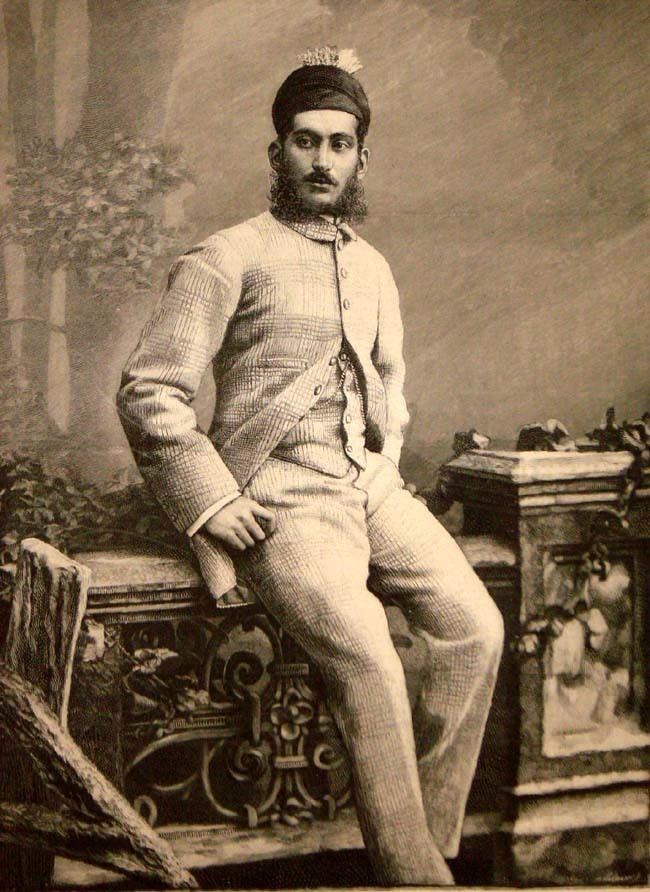Reign 1869–1911 Name Mahbub Khan, Successor Mir Osman Ali Khan Role Prince | Spouse Amat uz-Zehra Begum House Asaf Jahi dynasty | |
 | ||
Predecessor Afzal ad-Dawlah, Asaf Jah V Burial Mecca Masjid, Hyderabad, Hyderabad State, British India
(now in Telangana State, India) Died August 29, 1911, Falaknuma Palace, Hyderabad Parents Afzal ad-Dawlah, Asaf Jah V Children Osman Ali Khan, Asaf Jah VII Grandparents Nasir-ud-dawlah, Asaf Jah IV Similar People Osman Ali Khan - Asaf Jah VII, Moazzam Jah, Prince Azmet Jah | ||
Grandchildren Azam Jah, Moazzam Jah | ||
Asaf Jah VI Mir Mahboob Ali Khan Siddiqi Bayafandi (Urdu: آصف جاہ ششم میر محبوب علی خان صدیقی) (18 August 1866 – 29 August 1911) was the 6th Nizam of Hyderabad. He ruled Hyderabad state, one of the Princely states in India between 1869 and 1911.
Contents
(ribbon bar, as it would look today)
Official full name and style
Nawab Bahadur Sirajud Dawlah, Lieutenant-General His Highness Rustam-i-Dauran, Arustu-i-Zaman, Wal Mamaluk, Asaf Jah VI, Muzaffar ul-Mamaluk, Nizam ul-Mulk, Nizam ud-Daula, Nawab Mir Sir Mahbub Ali Khan Siddiqi Bayafandi Bahadur, Sipah Salar, Fath Jang, Nizam of Hyderabad, Knight Grand Cross of the Most Honourable Order of the Bath, Knight Grand Commander of the Most Exalted Order of the Star of India, Honourable Lieutenant-General in the Army.
Early life
Mir Mahbub Ali Khan was born on 18 August 1866 at Purani Haveli in Hyderabad State. He was the only son of Afzal ad-Dawlah, Asaf Jah V.
Life
When his father died he was two years and seven months old, and thus became the 6th Nizam of the Asaf Jahi dynasty in 1869. He was installed as Nizam by Mir Turab Ali Khan, Salar Jung I, Nawab Rasheed-ud-din Khan Shams-ul-Umra III who functioned as the Regent. Shams-ul-Umra III died on 12 December 1881 and Salar Jung I became the sole regent. He was retained as administrator and regent until his death on 8 February 1883. Special attention was paid to the education of Mahbub Ali Khan who was tutored by the English. With the concurrence of Salar Jung, Capt. John Clerk was appointed to tutor him and scholars well versed in Persian, Arabic and Urdu were also engaged as tutors. The personality and noble life of Sir Salar Jung had a great influence on Asaf Jah VI.
Asaf Jah VI was a respected ruler and was popularly known as Mahbub Ali Pasha. Dr. Abdul Husain, later given the title Arastu Yar Jung, was physician to Mahbub Ali Khan. As such, Asaf Jah VI often sought counsel for matters concerning the Bubonic plague epidemic that worried Hyderabad, and other matters as well. He died 29 August 1911, with a reputed annual income of US$10 million.
Lifestyle
Asaf Jah VI was well known for his lavish lifestyle and luxuries, and had an enormous fascination for clothes and cars. His collection of garments was one of the most extensive in the world at the time, with sherwanis, shirts, coats, collars, socks, shoes, headgear, walking sticks, perfumes – not one each, but dozens of almost each item. He devoted a whole wing of his palace to his wardrobe and would never wear the same dress twice. He bought the Jacob Diamond, which stands out among the Jewels of The Nizams now owned by the Government of India.
He was also fluent in Urdu, Telugu and Parsi languages. He also wrote poems in Telugu and Urdu; some of which are inscribed alongside the walls of Tank Bund.
Mystic powers
It was supposed that he possessed a healing power against snake bites. It was his order that if anyone from the public had a snake bite, they could approach him. He was awakened as a result a number of times.
Titles
Honours
(ribbon bar, as it would look today)
British honours
Foreign honours
